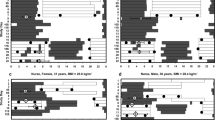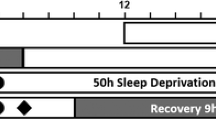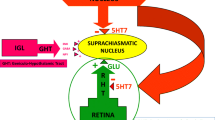Abstract
Rationale
Increased sleepiness while working and sleep disruptions are common complaints among shift workers. Consequently, shift workers may be more susceptible to diminished performance and work-related accidents.
Objective
To examine the effects of the central nervous system stimulant methamphetamine on psychomotor task performance, subjective effects, and food intake during shift work under laboratory conditions.
Methods
Seven participants completed this 23-day, within-participant design, residential laboratory study. They received a single oral methamphetamine dose (0, 5, 10 mg) 1 h after waking for three consecutive days under two shift conditions: (1) during the day shift, participants performed computerized psychomotor tasks from 0830 hours to 1730 hours and went to bed at 2400 hours and (2) during the night shift, participants performed tasks from 0030 hours to 0930 hours and went to bed at 1600 hours. Shifts alternated three times during the study; shift conditions were separated by an "off" day during which participants were not on a schedule and data were not collected.
Results
When participants received placebo, psychomotor task performance and subjective effects were disrupted during the night shift, relative to the day shift. Changing shift conditions did not alter food intake significantly. Methamphetamine reversed performance and subjective-effects disruptions, and decreased food intake during the night shift.
Conclusion
These data indicate that shift changes produce performance impairments and mood alterations, and that a single low to moderate dose of methamphetamine attenuates many shift change-related disruptions in performance and mood.


Similar content being viewed by others
References
Akaoka H, Roussel B, Lin JS, Chouvet G, Jouvet M (1991) Effect of modafinil and amphetamine on the rat catecholaminergic neuron activity. Neurosci Lett 123:20–22
Akerstedt T (1998a) Shift work and disturbed sleep/wakefulness. Sleep Med Rev 2:117–128
Akerstedt T (1998b) Is there an optimal sleep-wake pattern in shift work? Scand J Work Environ Health 24[Suppl 3]:18–27
Baranski JV, Pigeau RA (1997) Self-monitoring cognitive performance during sleep deprivation: effects of modafinil, d-amphetamine and placebo. J Sleep Res 6:84–91
Beaumont M, Batejat D, Pierard C, Coste O, Doireau P, Van Beers P, Chauffard F, Chassard D, Enslen M, Denis JB, Lagarde D (2001) Slow release caffeine and prolonged (64-h) continuous wakefulness: effects on vigilance and cognitive performance. J Sleep Res 10:265–276
Bjerner B, Holm A, Swensson A (1955) Diurnal variation in mental performance. Br J Industr Med 12:103–110
Bjorvatn B, Kecklund G, Akerstedt T (1998) Rapid adaptation to night work at an oil platform, but slow readaptation after returning home. J Occup Environ Med 40:601–608
Browne R (1949) The day and night performance of teleprinter switch board operators. Occup Psychol 23:121–126
Buguet A, Montmayeur A, Pigeau R, Naitoh P (1995) Modafinil, d-amphetamine and placebo during 64 hours of sustained mental work. II. Effects on two nights of recovery sleep. J Sleep Res 4:299–241
Chapelot D, Marmonier C, Thomas F, Hanotin C (2000) Modalities of food intake-reducing effect of sibutramine in humans. Physiol Behav 68:299–308
Comer SD, Hart CL, Ward AS, Haney M, Foltin RW, Fischman MW (2001) Effects of repeated oral methamphetamine administration in humans. Psychopharmacology 155:397–404
Couper FJ, Pemberton M, Jarvis A, Hughes M, Logan BK (2002) Prevalence of drug use in commercial tractor-trailer drivers. J Forensic Sci 47:562–567
Drug Enforcement Agency (DEA) (1995) Methamphetamine situation in the United States. Executive summary
Duteil J, Rambert FA, Pessonnier J, Hermant JF, Gombert R, Assous E (1990) Central alpha 1-adrenergic stimulation in relation to the behaviour stimulating effect of modafinil: studies with experimental animals. Eur J Pharmacol 180:49–58
Eastman CI, Martin SK (1998) How to use light and dark to produce circadian adaptation to night shift work. Ann Med 31:87–98
Eastman CI, Boulos Z, Terman M, Campbell SS, Dijk DJ, Lewy AJ (1995) Light treatment for sleep disorders: consensus report. VI. Shift work. J Biol Rhythms 10:157–164
Ferraro L, Tanganelli S, O'Connor WT, Antonelli T, Rambert F, Fuxe K (1996) The vigilance promoting drug modafinil increases dopamine release in the rat nucleus accumbens via the involvement of a local GABAergic mechanism. Eur J Pharmacol 306:33–39
Foltin RW, Haney M, Comer SD, Fischman MW (1996) Effects of fluoxetine on food intake of humans living in a residential laboratory. Appetite 27:165–181
Geliebter A, Gluck ME, Tanowitz M, Aronoff NJ, Zammit GK (2000) Work-shift period and weight change. Nutrition 16:27–29
Haney M, Ward AS, Comer SD, Foltin RW, Fischman MW (1999) Abstinence symptoms following smoked marijuana in humans. Psychopharmacology 141:395–404
Haney M, Ward AS, Comer SD, Hart CL, Foltin RW, Fischman MW (2001) Bupropion SR worsens mood during marijuana withdrawal in humans. Psychopharmacology 155:171–179
Hart CL, Ward AS, Haney M, Foltin RW, Fischman MW (2001a) Methamphetamine self-administration by humans. Psychopharmacology 157:75–81
Hart CL, van Gorp WG, Haney M, Foltin RW, Fischman MW (2001b) Effects of acute smoked marijuana on complex cognitive performance. Neuropsychopharmacology 25:757–765
Kelly TH, Foltin RW, Emurian CS, Fischman MW (1993) Performance-based testing for drugs of abuse: dose and time profiles of marijuana, amphetamine, alcohol, and diazepam. J Anal Toxicol 17:264–272
Knauth P, Rutenfranz J (1981) Duration of sleep related to the type of shiftwork. In: Reinberg A, Vieux N, Andlauer P (eds) Night and shiftwork biological and social aspects (Advances in the biosciences, vol 30). Pergamon Press, Oxford, pp 161–168
Leger D (1994) The cost of sleep-related accidents: a report for the National Commission on Sleep Disorders Research. Sleep 17:84–93
Lennernas M, Hambraeus L, Akerstedt T (1995) Shift related dietary intake in day and shift workers. Appetite 25:253–265
McLaren DS (1976) Nutrition and its disorders, 2nd edn. Churchill Livingstone, New York
McLeod DR, Griffiths RR, Bigelow GE, Yingling J (1982) An automated version of the digit symbol substitution test (DSST). Behav Res Meth Instr 14:463–466
Mignot E, Nishino S, Guilleminault C, Dement WC (1994) Modafinil binds to the dopamine uptake carrier site with low affinity. Sleep 17:436–437
Miller TP, Taylor JL, Tinklenberg JR (1988) A comparison of assessment techniques measuring the effects of methylphenidate, secobarbital, diazepam, and diphenhydramine in abstinent alcoholics. Neuropsychobiology 19:90–96
Mitler MM, Carskadon MA, Czeisler CA, Dement WC, Dinges DF, Graeber RC (1988) Catastrophes, sleep, and public policy: consensus report. Sleep 11:100–109
Muehlbach MJ, Walsh JK (1995) The effects of caffeine on simulated night-shift work and subsequent daytime sleep. Sleep 18:22–29
Ohayon MM, Lemoine P, Arnaud-Briant V, Dreyfus M (2002) Prevalence and consequences of sleep disorders in a shift worker population. J Psychosom Res 53:577–583
Pigeau R, Naitoh P, Buguet A, McCann C, Baranski J, Taylor M, Thompson M, Mack I (1995) Modafinil, d-amphetamine and placebo during 64 hours of sustained mental work. I. Effects on mood, fatigue, cognitive performance and body temperature. J Sleep Res 4:212–228
Perez-Reyes M, White WR, McDonald SA, Hicks RE, Jeffcoat AR, Hill JM, Cook CE (1991) Clinical effects of daily methamphetamine administration. Clin Neuropharmacol 14:352–358
Quera-Salva MA, Defrance R, Claustrat B, De Lattre J, Guilleminault C (1996) Rapid shift in sleep time and acrophase of melatonin secretion in short shift work schedule. Sleep 19:539–543
Reid K, Dawson D (2001) Comparing performance on a simulated 12-hour shift rotation in young and older subjects. Occup Environ Med 58:58–62
Roden M, Koller M, Pirich K, Vierhapper H, Waldhauser F (1993) The circadian melatonin and cortisol secretion pattern in permanent night shift workers. Am J Physiol 265:R261–R267
Romon M, Nuttens MC, Fievet C, Pot P, Bard JM, Furon D, Fruchart JC (1992) Increased triglyceride levels in shift workers. Am J Med 93:259–262
Rush CR, Kelly TH, Hays LR, Baker RW, Wooten AF (2002) Acute behavioral and physiological effects of modafinil in drug abusers. Behav Pharmacol 13:105–115
Sharkey KM, Fogg LF, Eastman CI (2001) Effects of melatonin administration on daytime sleep after simulated night shift work. J Sleep Res 10:181–192
Substance Abuse and Mental Health Services Administration (SAMHSA) (2002) Results from the 2001 National Household Survey on Drug Abuse, vol I. Summary of national findings. Office of Applied Studies, NHSDA Series H-17, DHHS Publication No. SMA 02–3758. Rockville, MD
Tallarida RJ, Murray RB (1981) Manual of pharmacologic calculations. Springer, Berlin Heidelberg New York
Tilley AJ, Wilkinson RT, Drud M (1981) Night and day shifts compared in terms of the quality and quantity of sleep recorded in the home and performance measured at work: a pilot study. In: Reinberg A, Vieux N, Andlauer P (eds) Night and shiftwork biological and social aspects. Advances in the biosciences, vol 30. Pergamon Press, Oxford, pp 187–196
Tilley AJ, Wilkinson RT, Warren PS, Watson B, Drud M (1982) The sleep and performance of shift workers. Hum Factors 24:629–641
U.S. Congress, Office of Technology Assessment (1991) Biological rhythms: implications for the worker. US Government Printing Office, Washington
U.S. Modafinil in Narcolepsy Multicenter Study Group (2000) Randomized trial of modafinil as a treatment for the excessive daytime somnolence of narcolepsy. Neurology 54:1166–1175
Walsh JK, Muelbach MJ, Humm TM, Dickens QS, Sugerman JL, Schweitzer PK (1990) Effect of caffeine on physiological sleep tendency and ability to sustain wakefulness at night. Psychopharmacology 101:271–273
Wesnes K, Warburton DM (1983) Effects of smoking on rapid information processing performance. Neuropsychobiology 9:223–229
Wiegmann DA, Stanny RR, McKay DL, Neri DF, McCardie AH (1996) Methamphetamine effects on cognitive processing during extended wakefulness. Int J Aviat Psychol 6:379–397
Acknowledgements
This research is dedicated to the memory of our mentor Dr. Marian W. Fischman. The assistance of Rachelle Reis-Larson, Mabel Torres, Shannon Lewis, Christine Figueroa, Nicole Cain, Tom Melore, and Drs. Anthony J. Tranguch, Vladimir Ginzburg, and Jeffrey Wilson are gratefully acknowledged. This research was supported by a grant from the National Institute on Drug Abuse (DA-03746).
Author information
Authors and Affiliations
Corresponding author
Rights and permissions
About this article
Cite this article
Hart, C.L., Ward, A.S., Haney, M. et al. Methamphetamine attenuates disruptions in performance and mood during simulated night-shift work. Psychopharmacology 169, 42–51 (2003). https://doi.org/10.1007/s00213-003-1464-4
Received:
Accepted:
Published:
Issue Date:
DOI: https://doi.org/10.1007/s00213-003-1464-4




